Behind the Mic: My journey to delivering a conference talk
Posted on December 26, 2024 • 10 minutes • 2078 words
Table of contents
I recently gave a talk with Tittu Varghese on “Questioning database claims: Design patterns of storage engines” at GopherConIndia24 on 2nd December. The idea of the talk was to understand various patterns of storage engines (/key-value storage engines) such as:
- Persistence (WAL, fsync)
- Efficient Retrieval (B+tree, bloom filters, data layouts)
- Efficient Ingestion (Sequential IO, LSM, Wisckey)
and then question a variety of database claims like durability, read optimization, write optimization and pick the right database(s) for our use case.
In this article, I’ll walk you through my journey - from brainstorming the topic and building the presentation to running mock sessions and delivering the final talk. Along the way, I’ll share the experiences and emotions that shaped my path to the stage.
Let’s start.
Picking the topic
Having spent decent time exploring key/value storage engines, I was eager to present my learnings on recurring patterns within this space. I define a pattern as a repeating or a recurring solution to a problem . For instance, the pattern Persistence – refers to ensuring that data is never lost after being acknowledged as stored – requires the implementation of a Write-Ahead Log (WAL) along with fsync system call.
My initial concept for the talk centered around “Patterns of Key/Value Storage Engines”. I was going to present the talk with Tittu Varghese , who is an architect at NPCI. Both of us recognized the need to refine the topic further. Despite our understanding of these patterns, we sought to ensure the talk offered a more focused and impactful message.
To do this, we discussed it with Gautam Rege during a call. This conversation proved invaluable. We discussed the key takeaways for the audience and all of us agreed that the audience should not only grasp key/value storage engine patterns but also develop a critical lens to evaluate database claims. By understanding these patterns, they would be better equipped to question the promises made by various database solutions.
As a result of this discussion, the focus of our talk shifted to “Questioning database claims: Design patterns of storage engines”.
Building a task list
Choosing the topic was only the beginning. I then had to outline the specific tasks involved in delivering the talk. I believe I am good at breaking down a complex project into manageable tasks. I created a task list with everything that I could think of. Preparing a healthy task list has a lot of advantages:
- Enhanced Visibility: A clear task list provides a comprehensive overview of the entire project, enabling better tracking of progress and identifying potential roadblocks.
- Improved Focus: Concentrating on individual tasks allows maintaining a steady pace and minimizing the feeling of being overwhelmed.
- Reduced Anxiety: A well-defined task list minimizes anxiety by providing a clear roadmap and a sense of control over the project.
My refined task list is shown below.
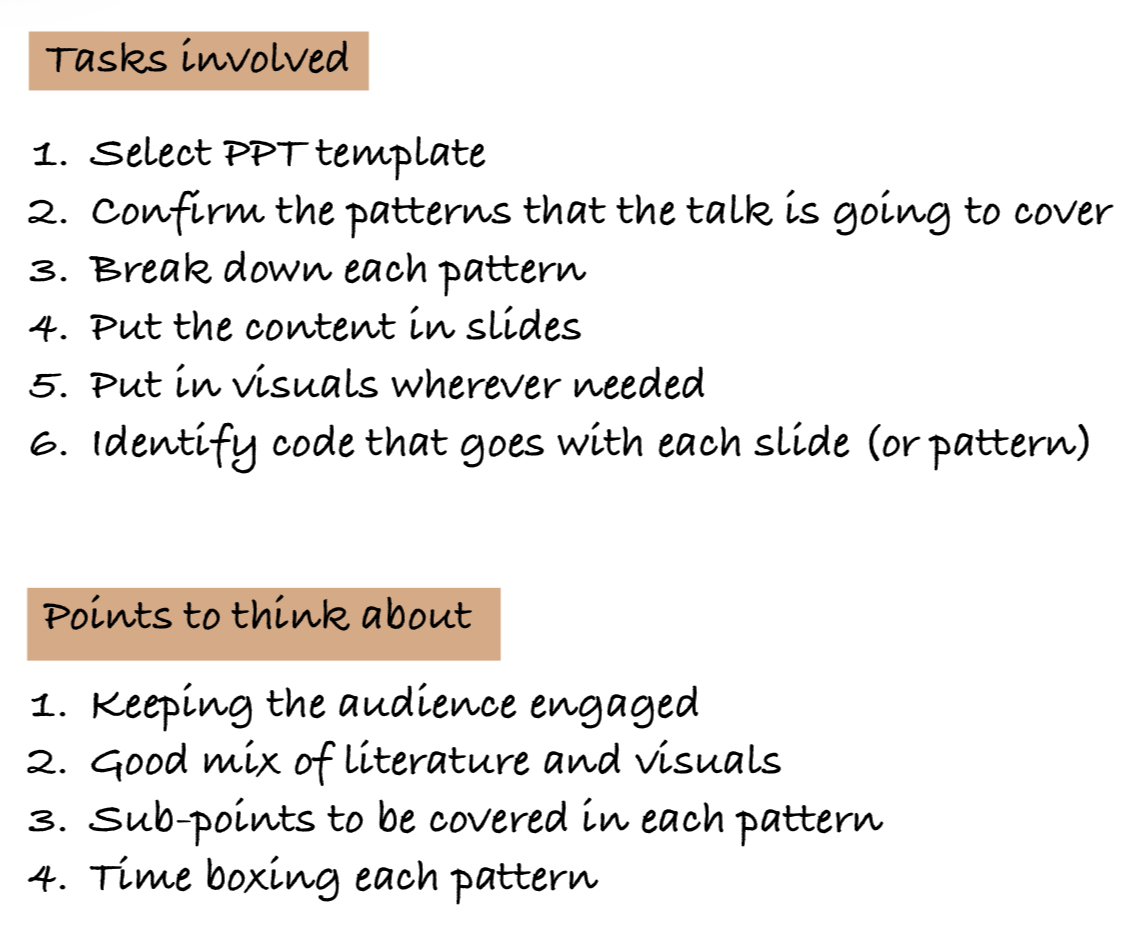
I then moved on to preparing the presentation.
Preparing the presentation
After the topic was finalized and task list prepared, I identified four key patterns of key-value storage engines to cover in the talk:
- Durability
- Read optimization
- Write optimization
- Transactions
Although I wasn’t entirely satisfied with the names of the patterns, I decided to move forward with them. To organize my thoughts, I created a simple template to structure the presentation:
Pattern name → Definition → Sub-concepts → Questions to evaluate database claims
I had a great brainstorming session with Unmesh Joshi around patterns of storage engines and questions that one should ask to evaluate database claims. I received valuable feedback on the pattern names, suggesting that they should be nouns. Based on this input, I refined the names of the patterns as follows:
- Durability → Persistence
- Read Optimization → Efficient Retrieval
- Write Optimization → Efficient Ingestion
- Transactions → Coordination
The template provided a clear framework to organize my ideas and the discussion with Unmesh helped in refining it. To give an example, the draft structure for the “Persistence” pattern took the following shape:
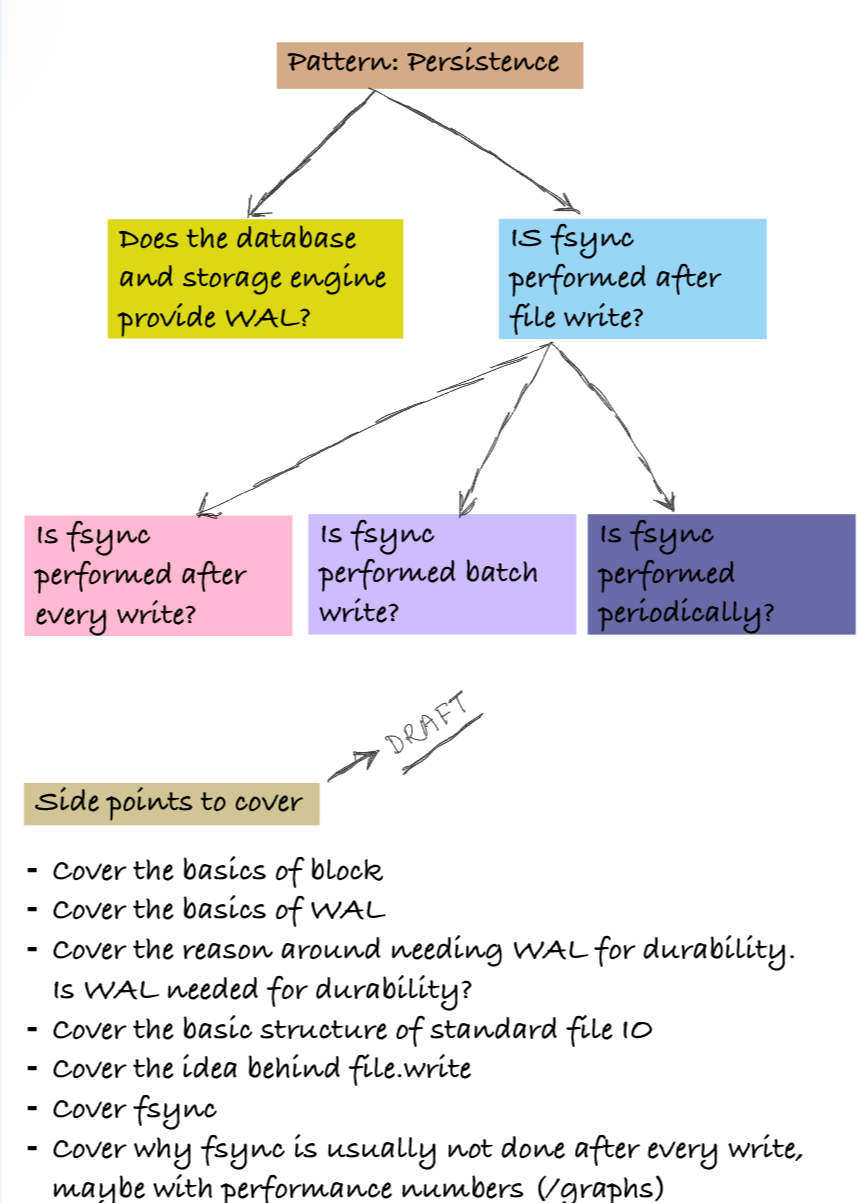
The root is the name of the pattern, followed by a set of questions designed to validate the “durability” claim of databases. The template concludes with a list of potential points that I might to cover in this pattern.
I applied the same approach to all the patterns, and soon enough, my presentation was ready. Initially, I drafted a list of “side points to cover” in each pattern, as seen in the image above. However, I refined this list by conducting timed practice sessions. This iterative process helped me in determining which points were essential to include within the allotted time frame.
I moved on to the next stage, which was getting feedback on the presentation.
Getting feedback on the presentation
My presentation started with an examination of various database claims. It then delved into key/value storage engine patterns and a set of questions for evaluating various database claims. However, I felt a sense of incompleteness, as if a crucial element was missing, though I couldn’t quite articulate what it was.
I had a call with Gautam Rege and I received some insightful feedback:
- Revisit those claims at the end of each pattern
- Conclude the presentation with some use cases, where the audience can select the appropriate database(s) or key/value storage engine(s).
This was a wonderful call because it gave a clear vision for my talk. I could describe the talk to anyone with the following flow:
Understand patterns of storage engines → Question database claims → Apply patterns.
During the call, I also received valuable information about the timing of the talk - it needed to be completed within 22-25 minutes. This meant I couldn’t dive too deeply into any one pattern. Additionally, the use cases at the end of the talk needed to be simple enough for the audience to quickly grasp and apply the patterns to choose the right database(s) or key/value storage engine(s).
I went back and made the necessary changes. The presentation felt complete now. The feedback resulted in addition of some very important slides, the image of one such slide is shown below.
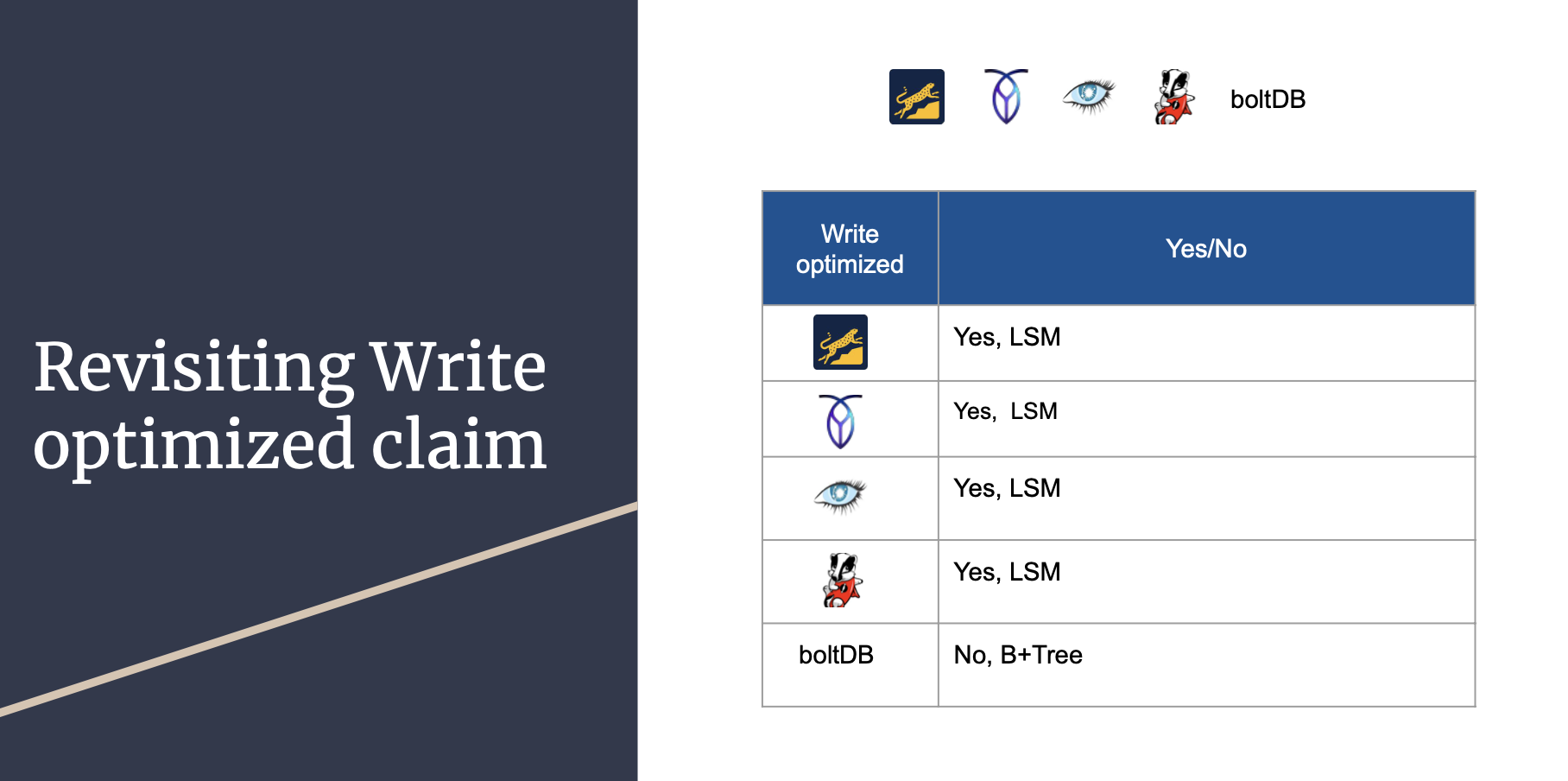
Practice round 1
With my presentation ready, the next step was to practice (in a closed room :)). Since this was the first practice round, I didn’t focus on timing just yet. Instead, I aimed to work on the following areas:
- Listening to myself
- Self-evaluating whether I was able to simplify difficult concepts for the audience
- Focusing on my tone, clarity, and ensuring that I didn’t sound nervous or have my breathing interfere with my speech
- Removing redundant sentences while speaking
I didn’t start by practicing the entire talk. Instead, I focused on one pattern at a time, evaluated my mistakes, and once I felt confident with a pattern , I moved on to a few full practice sessions of the entire talk.
I practiced 5-7 times and things started to fall in place. However, there were still two key areas that I had to work on:
- Timing of the talk
- Audience engagement
Each time I practiced, the talk lasted between 25-28 minutes, with zero audience engagement. By that, I mean I was not interacting with the audience at all. This made it clear that I had to create enough opportunities in the talk to engage with them - whether it was to wake them up, ask questions, or perhaps even incorporate some humor.
Travelling to Jaipur
GopherCon India 2024 was held in Jaipur, and my talk was scheduled for December 2nd. I traveled to Jaipur on the evening of November 30th, giving me one day to focus on improving the two key areas of my talk. On December 1st, I attended a few sessions and took notes on the following:
- Talk time of various speakers
- Attention span of the audience
- Any issues the speakers encountered with the microphone or presentation screen
I did not see any issues with the microphone or the presentation screen. However, I realized that it was crucial to finish my talk under 25 minutes to allow the audience time for questions. Another important realization was that without engaging the audience, it would be difficult to convey the essence of the talk.
I went back to my room to work on “talk timing” and “audience engagement”. Before practicing, I thought of showing my slides to Aman Mangal . Aman is a good friend and works at Dgraph. He provided valuable feedback, suggesting that I add slides to explain key concepts like B+Tree, Bloom filter, WAL, and others. Taking his advice, I integrated slides within each pattern to provide clear explanations of these core concepts. An example of one such slide is shown below.
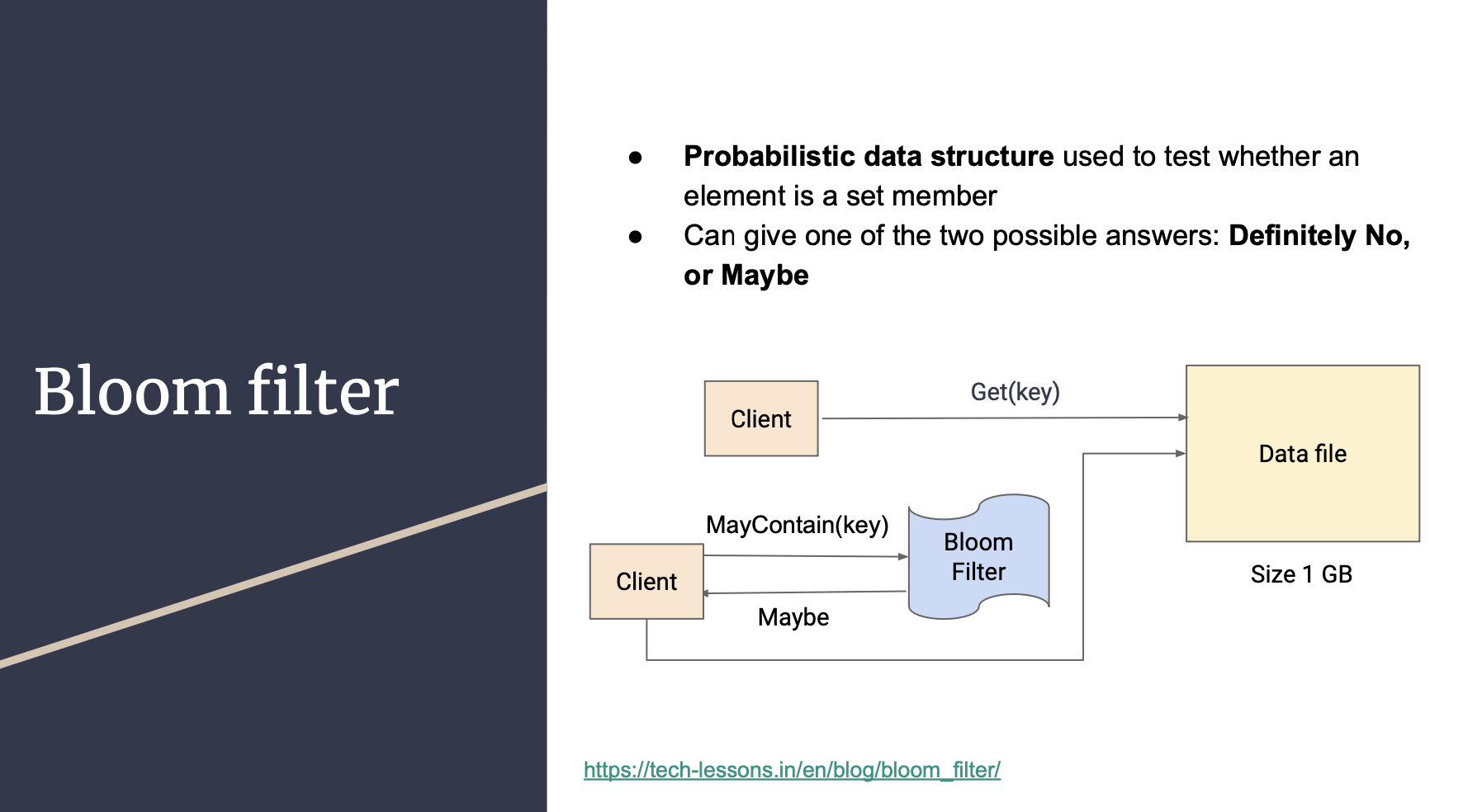
Now was the time to do a few more mock runs.
Practice round 2
I decided to remove the “Coordination” pattern from the talk. At first, it felt like I was doing the talk an injustice, but the most important thing was to help the audience grasp patterns like Persistence, Efficient Retrieval and Efficient ingestion along with the underlying concepts like WAL (write-ahead log), fsync, B+Tree, Bloom filter etc. I wanted them to realize the value of understanding these patterns to effectively question database claims and choose the right database(s). I was able to convince myself with the idea of dropping the “Coordination” pattern.
After practicing again, my talk time dropped to 21 minutes.
It was now the time to involve the virtual audience. To do this, I revisited the slides and looked for opportunities to engage them.
I was able to create enough engagement points in the slides:
One observation I made on December 1st was that while the speakers were greeted by the audience, the applause wasn’t very loud. I saw this as an opportunity to inject some humor and create a brief moment of audience engagement.
On the slide discussing claims of various databases and key/value storage engines, I decided to ask the audience to identify the icons.
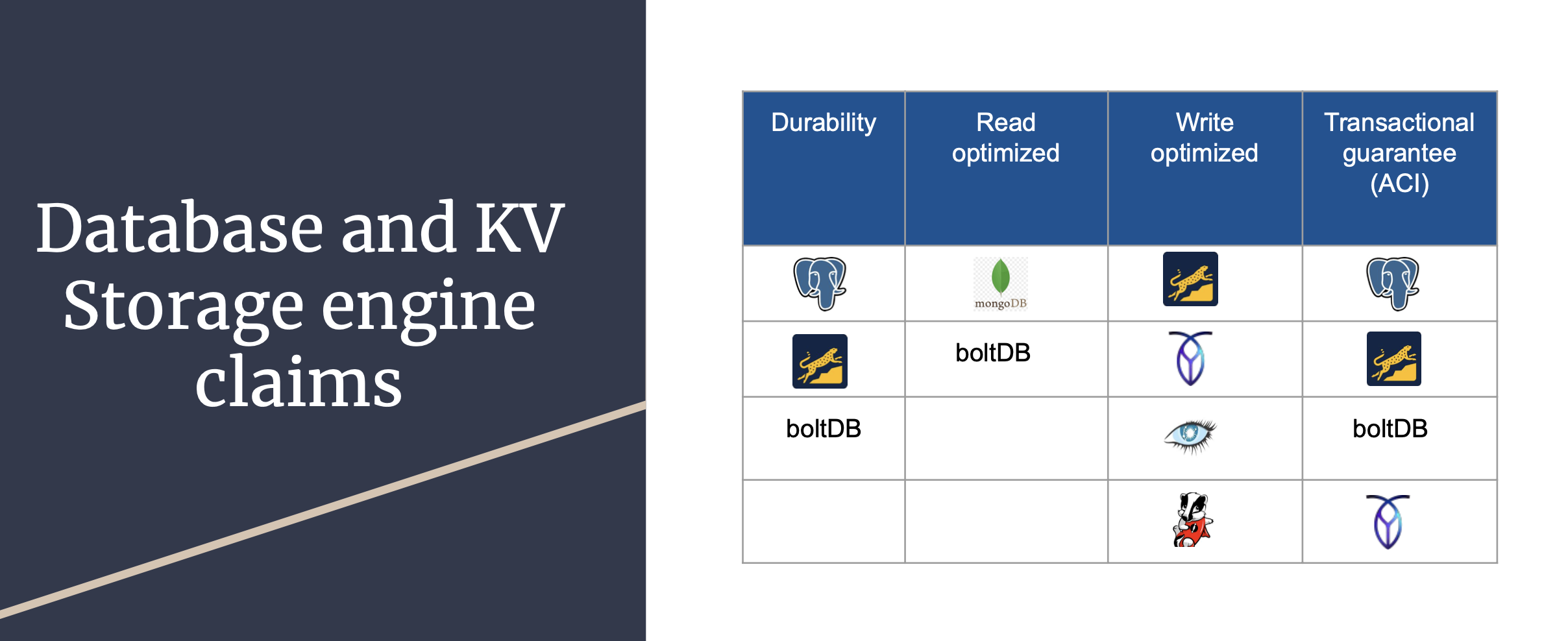
- Based on Gautam Rege’s feedback, I had already added a slide at the end of each pattern to revisit the database claims. This time I incorporated animations in these slides (by hiding the table in the image below) and decided to ask the audience whether the listed databases (or storage engines) satisfied the given claim.
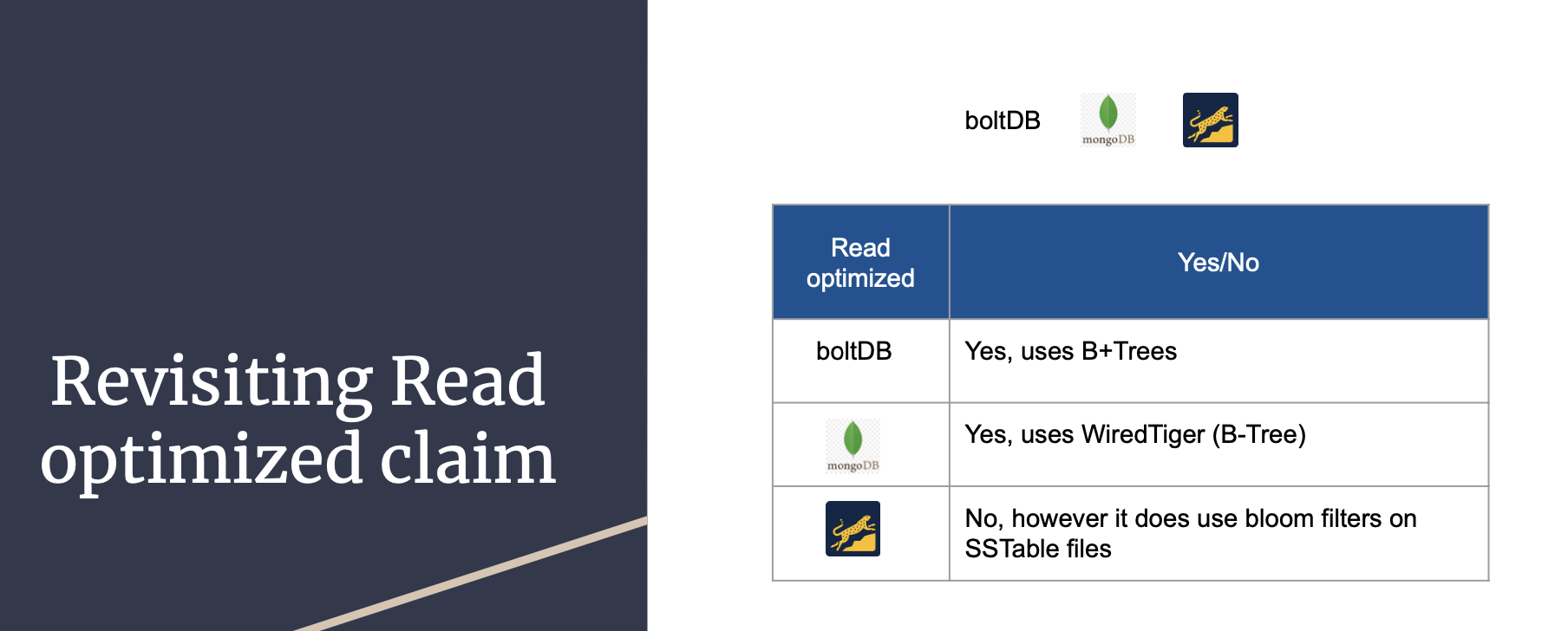
- Finally, I added animations in “Applying patterns” slides. I decided to ask the audience to pick database(s) or key/value storage engines for the given use-case.
I practiced again, this time engaging with the virtual audience. Given the audience was virtual, I decided to add 40-50 seconds on each engagement point. I felt confident now. Each time I practiced, the talk wrapped up just under 25 minutes, though it was very close to the limit.
Giving the talk
Practice is very different from actual talk. I knew I had practiced enough, but I was well aware of the fact that I might get nervous on the stage. My anxiety wasn’t about the audience or the stage, but about the pressure to perform well, deliver my message accurately, and truly capture the essence of my talk. So, I wanted to feel a little of that pressure beforehand.
This is where Tittu Varghese helped. I shared the stage with Tittu. He skillfully provided the necessary context for the talk, creating a smooth transition for my presentation. Tittu spoke for a few minutes, which proved invaluable. This period allowed me to get comfortable with the stage, observe the audience, and build my confidence for the rest of the presentation.
I finally gave the talk :). I believe it went well, and I received positive feedback.
Introspection
Reflecting on the experience, I realize that while I delivered the talk, its success was truly a team effort. I am incredibly grateful to Unmesh Joshi, Gautam Rege, Aman Mangal, and Tittu Varghese, whose invaluable input and support were instrumental in shaping this presentation.
The mock practice sessions proved invaluable. Timing myself during rehearsals helped me develop a comfortable pace, significantly reducing my anxiety about exceeding the allotted time.
This experience has reinforced the importance of meticulous preparation and the value of seeking feedback from colleagues. I encourage anyone considering submitting a talk proposal to embrace the challenge. The rewards - sharing your knowledge, connecting with the community, and growing as a presenter - are truly immense.
I am deeply grateful to Thoughtworks, NPCI, and Caizin for their invaluable support in making this presentation a reality.
The recording of the talk is available here and the slides are available here .
ChatGPT helped with the article.

